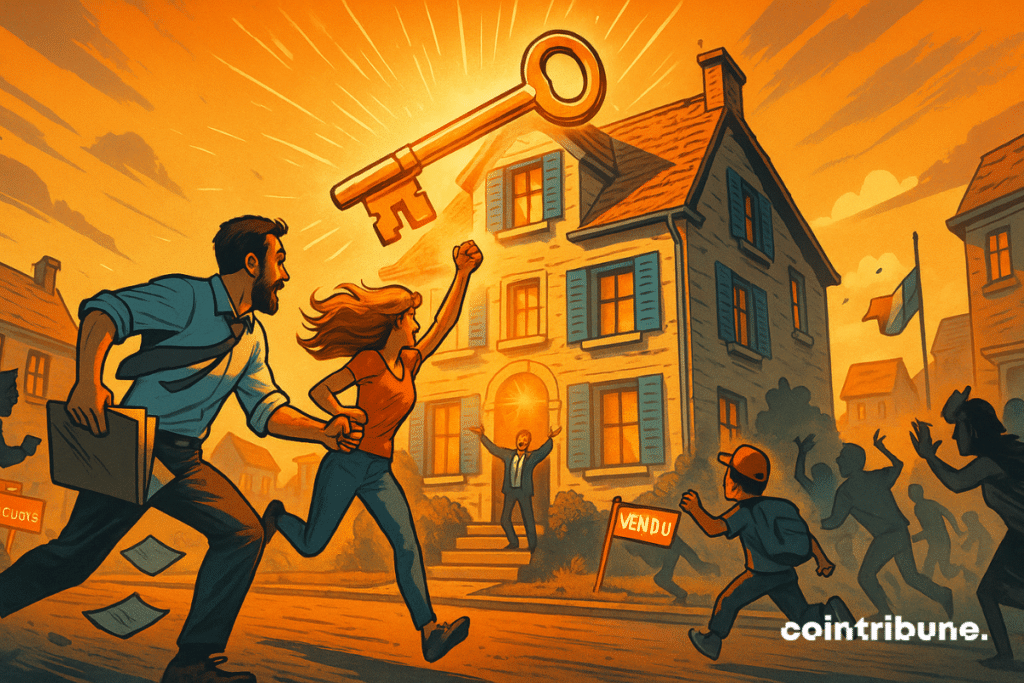16h05 ▪
5
min read ▪ by
The mortgage credit market, long at a standstill, is showing a clear recovery. In two months, loan demand has nearly doubled, driven by a drop in interest rates and a reopening of bank lending. After two years of stagnation due to the sharp increase in the cost of money, a turnaround was expected. However, is this improvement sustainable or just a catch-up effect? While April marks a turning point, the sector wonders: are we witnessing the start of a cycle or a fragile pause?

In Brief
After a long slowdown, mortgage credit in France is seeing a strong restart in the spring.
Loan demand jumped to 12.6 billion euros in April, compared to only 6.9 billion in February, according to the Bank of France.
This recovery is fueled by a marked drop in interest rates, which fell to an average of 3.13% in April.
Economic uncertainties, supply pressures, and the ECB’s future decisions keep the recovery fragile.
A Tangible Recovery Driven by Falling Rates
Real estate prices are rising again after eighteen months of decline. Thus, the demand for mortgage loans in France has seen a strong rebound since the beginning of spring. According to figures from the Bank of France, the amount of new loans reached 12.6 billion euros in April, compared to 6.9 billion euros in February, which then marked a ten-year low.
After a complicated year 2024 for the real estate market, the signs of recovery are confirmed. The trigger for this turnaround was the marked drop in interest rates, which began in the first quarter of the year.
Here are the most competitive rates observed:
2.55% over 10 years;
2.65% over 15 years;
2.90% over 20 years;
3.00% over 25 years.
Furthermore, the average rate for home loans (excluding renegotiations, fees, and insurance) dropped to 3.13% in April, compared to 3.20% in March and 4.2% at the beginning of the year. This change, described as a “clear decline”, largely explains the return of borrowers to the market.
The governor of the Bank of France, François Villeroy de Galhau, also confirmed on France 2 that “the current context is favorable to borrowing”. He highlighted the significant gap compared to rates a few months ago.
Banks, by gradually easing their scales, are thus reinjecting a minimum of liquidity into a market previously clogged by the cost of credit.
Signs of a Slowdown: Is the Recovery Already Under Strain?
This momentum remains fragile. Indeed, an increase in the average rate was observed as early as May, marking a first inflection since December 2023. Unlike the trend seen in April, this rise affects all types of projects (new real estate, old, or renovation), and all durations.
While the average rate remains contained around 3.1%, it could stabilize or even slightly rise in the coming months. These developments indicate that the current window may close more quickly.
The mentioned stabilization occurs in a context of cautious waiting among banking institutions. In early June, 87% of rates remained stable, while only 13% dropped further, mainly on short durations.
In other words, the rapid downward adjustment trend of rates seems to be waning. This situation could prompt many prospective buyers to accelerate their steps, fearing that financing conditions may tighten again.
Meanwhile, persistent tensions on property supply, macroeconomic uncertainties, and the ECB’s monetary policy developments will continue to play a key role in the coming months.
In this context of eased credit access conditions, some borrowers are also considering alternative financing methods, notably through the mobilization of capital gains from crypto investments, with bitcoin at the forefront, which for some becomes a lever to build a down payment or secure a real estate project.
While the mortgage credit recovery is undeniable thanks to the ECB’s rate cuts, it still rests on uncertain grounds. The return of more favorable credit conditions has certainly breathed new life into the market, but recent signals suggest this positive cycle could be short-lived. Between stabilization, potential regulatory adjustments, and European monetary developments, the coming weeks will be decisive to determine whether this awakening is a temporary rebound… or the start of a new structural cycle.
Maximize your Cointribune experience with our “Read to Earn” program! For every article you read, earn points and access exclusive rewards. Sign up now and start earning benefits.
Diplômé de Sciences Po Toulouse et titulaire d’une certification consultant blockchain délivrée par Alyra, j’ai rejoint l’aventure Cointribune en 2019.
Convaincu du potentiel de la blockchain pour transformer de nombreux secteurs de l’économie, j’ai pris l’engagement de sensibiliser et d’informer le grand public sur cet écosystème en constante évolution. Mon objectif est de permettre à chacun de mieux comprendre la blockchain et de saisir les opportunités qu’elle offre. Je m’efforce chaque jour de fournir une analyse objective de l’actualité, de décrypter les tendances du marché, de relayer les dernières innovations technologiques et de mettre en perspective les enjeux économiques et sociétaux de cette révolution en marche.
DISCLAIMER
The views, thoughts, and opinions expressed in this article belong solely to the author, and should not be taken as investment advice. Do your own research before taking any investment decisions.




